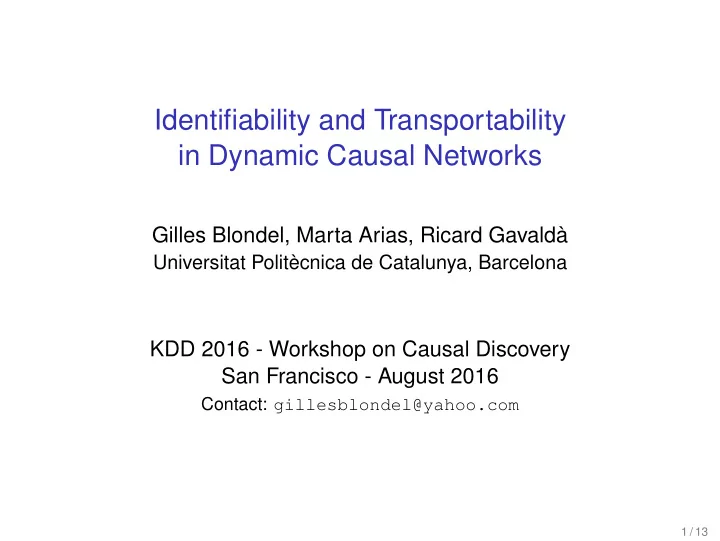

Identifiability and Transportability in Dynamic Causal Networks Gilles Blondel, Marta Arias, Ricard Gavaldà Universitat Politècnica de Catalunya, Barcelona KDD 2016 - Workshop on Causal Discovery San Francisco - August 2016 Contact: gillesblondel@yahoo.com 1 / 13
Causality vs Correlation Correlation gives no information about causes and effects: ◮ yellow fingers and lung cancer ◮ smoking and yellow fingers ◮ lung cancer and smoking Causal graphs: ◮ Cause to effect relations ◮ How do we know what causal relations exist? (a) (b) (c) 2 / 13
Causal Graphs: How to build them? Performing experiments: ◮ World Health Organisation: "Processed meat causes cancer" ◮ Result based on experiments (animals, cell based research); not on observation alone From observational data: ◮ Experiments may be expensive, unethical, impossible ◮ Observational data contains hints towards causal relations ◮ Causal discovery algorithms (since 90’s) ◮ PC, IC, IC*, FCI, RFCI... 3 / 13
Causal Reasoning Once we have a causal graph... Causal reasoning: ◮ Intervention: force a variable and evaluate the effect ◮ Expressed as P ( Y | do ( X )) ◮ All natural causes of X (incoming edges to X in the causal graph) are disabled Tool: rules of do-calculus (Pearl): 1. P ( Y | Z , W , do ( X )) = P ( Y | W , do ( X )) if ( Y ⊥ Z | X , W ) G X 2. P ( Y | W , do ( X ) , do ( Z )) = P ( Y | Z , W , do ( X )) if ( Y ⊥ Z | X , W ) G XZ 3. P ( Y | W , do ( X ) , do ( Z )) = P ( Y | W , do ( X )) if ( Y ⊥ Z | X , W ) G XZ ( W ) 4 / 13
Identification of Causal Effects ◮ P ( Y | do ( X )) is ’Identifiable’: If it can be uniquely computed from observational probability distributions in G ◮ Apply do-calculus rules ◮ Not all effects are identifiable (due to hidden confounders) ◮ Identification algorithm (Shpitser/Pearl 2006) ◮ Example: P ( d | do ( s 2 )) = expression without do() terms; or fail 5 / 13
Identification of Dynamic Causal Effects Adding time component to the identification problem: ◮ Existing research did not formally address dynamic causal identifiability via do-calculus ◮ Our paper formally addresses dynamic causal settings with do-calculus ◮ Algorithm DCN-ID for Dynamic Causal Network identification Example: calculate the probability of d some time α after doing an intervention on s 2 6 / 13
Dynamic Causal Networks ◮ DCN: DBN where relations are causal (a) DCN (b) DCN expanded graph (bi-infinite) ◮ Hidden confounders: Static vs Dynamic 7 / 13
DCN Analysis with Do-Calculus How to apply do-calculus to DCN: ◮ Exploit time slice d-separation by careful conditioning ◮ Heavy dependence on static/dynamic hidden confounders DCN causal effect identification: ◮ we can limit time scope of graph (attention: confounders) ◮ reduce complexity of identification algorithms ◮ past (before intervention): no effect ◮ present (local graph around intervention): apply existing ’static’ id algorithms ◮ future (after intervention): DCN may or may not recover ’natural’ behaviour (static vs dynamic hidden confounders) 8 / 13
DCN Identification Algorithm ◮ Markov chain: P ( V t + 1 ) = TP ( V t ) ; transition matrix T ◮ Intervention at t x : 1. transition matrix T 2. transition matrix A � = T 3. transition matrix T (static hidden confounders) transition matrix M t � = T (dynamic hidden confounders) 9 / 13
DCN Transportability Algorithm ◮ Two domains D 1 , D 2 ◮ Modeled with the same dynamic causal graph ◮ We perform experiments in D 1 ◮ Causal effect identification in D 2 may use experiments from D 1 10 / 13
Example: DCN Causal Effect Identification Two roads between two cities with traffic tr 1, tr 2 Find average traffic delay evolution P ( d | do ( tr 1 )) 11 / 13
Conclusions ◮ Dynamic causal identification with do-calculus algorithms ◮ DCN-ID algorithm for static, dynamic hidden confounders ◮ DCNs with static hidden confounders do recover pre-intervention behaviour after intervention ◮ DCNs with dynamic hidden confounders may not recover pre-intervention behaviour 12 / 13
Identifiability and Transportability in Dynamic Causal Networks Gilles Blondel, Marta Arias, Ricard Gavaldà Universitat Politècnica de Catalunya, Barcelona KDD 2016 - Workshop on Causal Discovery San Francisco - August 2016 Contact: gillesblondel@yahoo.com 13 / 13
Recommend
More recommend